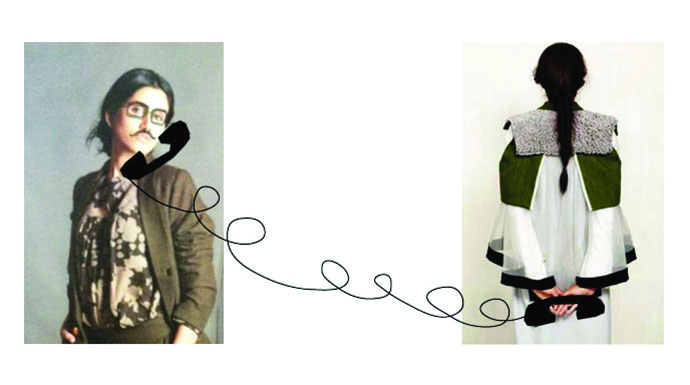Nimish chats with Ruchika after she returns from troubleshooting a short circuit in her studio.
Nimish: I am sure Christopher Kane or Henry Holland’s job profile doesn’t include ‘negotiate with electricians’.
Ruchika: Yes, but they have investors funding them, not their personal savings. Plus Hauz Khas village is hardly Dalston! You know, Hauz Khas used to be so naïve; a subcultural epicenter – now it’s mainstream and greedy. It is changing so fast – everyday there is something new. It’s such a far cry from what it used to be when I opened up the studio/shop in 2010, looking for a quiet place to work from.
Nimish: We have Kala Ghoda; a bit like Hauz Khas. It has its moments of being alternative and then sometimes it’s flat out commercial. But the rentals are ridiculously high compared to Hauz Khas. It seems to be increasingly important to have flagship stores – even for new designers. It’s cool that you have your own shop, I’m assuming it serves you quite well?
Ruchika: Yes, I’m quite lucky in that my store is an extended studio and showroom. We are on the second floor in a back lane, so only people who have already heard of the brand come to check it out, I do wish I had a window space on the ground floor. On the upside, people spend quite a lot of time in this neighborhood; it is not at all intimidating. It definitely makes a difference having a shop – it’s a great opportunity to communicate the brands aesthetics.
Nimish: Also, from a pure sales perspective it must be such a convenience. Wholesale distribution in our category of design is in its infancy. We end up attending to numerous sales, managing the micro details; either through alterations from our stockists or custom orders. Since you are already dealing with issues of direct retail, you might as well serve tea!
Ruchika: Yes and I don’t see that changing anytime soon. I think it’s our customers mindset; they make designer shopping an event. I think they gain more value by making special requests, unlike shopping ready to wear at the mall. No wonder more retailers prefer consignment; they have to constantly offer new things to keep up with the demand for new and different styles!
Nimish: I don’t know why designers hesitate to consign, as long as the retailer is making an effort and equally enthusiastic. Sometimes it gives a better chance for product circulation and brand presence. Although it’s a big bummer when goods are returned back – all at the same time right at the end of a season.
Ruchika: Yes, the inventory overheads involved are similar – you would carry the same risk at your own store. In a city notorious for a tough retail environment, working with other retailers gives a great chance to test unknown waters. Though ‘dead stock’ in fashion is like a skeleton in closet – no one in the industry is spared! I also think about the role of e-commerce, a much newer retail segment. Do you shop online?
Nimish: Yeah, lots! Books and items that are not available here. I only make fashion purchases from brands whose sizing I am familiar with. Shoes – I buy without hesitation! Saying so, I am still an old soul and like the ‘touch and feel’ experience. I don’t know what its future is though. How are sales for you? Your website helps, kya? I need to get my act together and develop a site very soon.
Ruchika: It’s pretty good even though it’s new… slow, but promising. For now, a website functions like a business card, almost a ‘checklist’ item. But it’s quite important if you want to build towards an e-shop. Things are hopeful; the timing for e-commerce is right, no matter how many of them come there is always room for more. People are shopping online, one can’t deny that (especially from cities with less access to fashion brands). More than my website, social media really helps. It has such relevant outreach even though there is little scope for creative communication since we have to follow a template – but it works like magic! Every new information we to communicate goes in the news feed, if a friend ‘likes’ a picture – other friends find out. In a short span of time you see several ‘likes’, almost like a registered postal service – you know they know.
Nimish: Completely agree, can you imagine how much time and effort it takes to make changes on your webpage? Here, it’s a click away. My entire digital portfolio only exists on Facebook. The best part? Fans, long lost school friends in my case, put pictures of Shift that they have seen a magazine or at a store. You know they want to support you and take such pride – it’s humbling. Despite an industrial marketing pattern, you can establish an honest connect. Digital space allows so much creativity too – you know this well, I absolutely loved the making of you’re A/W ’12 look book and short fashion film.
Ruchika: I like exploring different ways of establishing a creative connect with the audience. There is a small budget and only few ways one can explore within that. Having said that, there is a crop of young creatives out there attempting something alternative with a unique aesthetic so it’s great to collaborate with them. For example, I collaborated with Tsundue Phunkang for the AW’12 Bodice film. I also collaborate with multi-talented graphic designer Gursi Singh (he designed Boheme in Hauz Khas village). We make compelling visuals for social media, work on the look-book together etc. I usually thank him by making clothes in return. Therefore, it’s usually not a commercial assignment and gives us the freedom to push boundaries. Plus, it gives me a refreshing chance to explore a medium apart from clothes. I love this challenge and the outcome is always so fresh and yet refined.
Nimish: I relate to this completely and try to bring out the same essence in living spaces, as I am inclined to old world minimalist methods. I want to create a pocket of nostalgia in a physical space. It is so challenging to do this online with a limited budget. It is difficult to appeal to our five senses through visual and audio – I rely on sensory perception quite heavily. For instance, Hermès and Viktor & Rolf all created versions of virtual shops, but they lacked some human connect. With internet communication being a challenge in this sense, sometimes I think catalogue style websites look best, rather than attempting something which comes across as ‘artsy mumbo-jumbo’.
Regarding retailing, I don’t know what’s next. Almost ten years back, retailers were holding trunk shows and thinking of pop-up shops, yet we saw e-commerce as ‘the next big thing’. I don’t see an expiry for this – hence remain quite uncertain and wouldn’t know how to get ahead of the curve. I wonder what Net-a-Porter is thinking of next. Did you ever see their couture lab? That was a superb vision – don’t think it took off, but eventually they had their own store. Even Oki-ni for that matter. They had a physical store where one could see the product but had to still order online – such an innovative way to educate customers – and I am talking a decade back! Of late there is LN-CC, but shops like that are far and few between.
Ruchika: You think too much, we are only selling clothes! I get the whole deal but it’s still just a frock! I also think the role of customer education is so often misunderstood while making a sale. There is so much scope and requirement to educate the sales team who in turn can inspire the client. Bollywood influences customers to a great extent, but with such limiting and tired options… what we need are parallel influencers. Mass clothing companies take few risks. Most of the mainstream media does its job just like retailers – with hands tied and relevant to a specific agenda. We need something like Dazed and Confused. Something that stays on your table and inspires you.
Nimish: I think something home grown, rather than another template. I love Motherland for that matter – it’s quite precise and makes relevant commentary to subculture – without the noise.
Chal now – we could speak for hours… back to work. Over and out!
Ruchika: Agreed (laughs) … take care and speak soon, bye!
_________________
Nimish Shah is the Founder and Designer of SHIFT
Ruchika Sachdeva is the Founder and Designer of Bodice and is / was a client of the Border&Fall Agency




